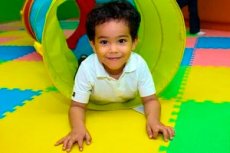Medical expert of the article
New publications
Activities with a child with alalia
Last reviewed: 07.06.2024

All iLive content is medically reviewed or fact checked to ensure as much factual accuracy as possible.
We have strict sourcing guidelines and only link to reputable media sites, academic research institutions and, whenever possible, medically peer reviewed studies. Note that the numbers in parentheses ([1], [2], etc.) are clickable links to these studies.
If you feel that any of our content is inaccurate, out-of-date, or otherwise questionable, please select it and press Ctrl + Enter.

In the case of delayed speech development in children - motor, sensory or sensorimotor alalia - speech and communication skills should be developed from the age of three or four, for which speech therapy classes are conducted with a child with alalia and a disorder of expressive or receptive speech.
Based on an individual approach to each child and taking into account the level of his/her speech development, correction of alalia in preschoolers is carried out in the process of play, contributing to the development of cognitive abilities, motor skills and perception, mastering the basic language forms and enriching the vocabulary, which positively affects the dynamics of speech functions. [1]
Speech therapy with a child with motor alalia
In a child with motor alalia - expressive speech disorder - speech therapy sessions are aimed at activating speech function and are designed to teach how to recognize sounds, adequately reproduce them and use them for communication.
According to the existing methods, the structure of the classes includes:
- correction of pronunciation of sounds with the establishment of the correct use of the articulation apparatus;
- Formation of an idea of the sound and syllabic structure of words;
- mastering the principles of word formation and word formation, as well as grammatical systems of language and speech;
- vocabulary building;
- teaching the rules of construction of word combinations and simple sentences of different types.
It usually starts with teaching the child to recognize, distinguish the voices of animals and imitate them.
Then they memorize short and simple words - names of objects (body parts, toys, etc.) actions, signs (depicted or presented). It can take a long time to correct omissions or rearrangements of syllables in words, so frequent repetition of correct pronunciation of syllables is necessary.
A special role in the formation of speech is played by memorization and repetition of short phrases of two or three words (noun + verb), necessary for the child's everyday communication.
As the correctional work progresses, the tasks become more complex: they include learning to change words (nouns - by case, verbs - by tense), mastering new parts of speech and matching them in sentences, building phrases of four or five words (by reference words, by picture, etc.). [2]
Speech therapy with a child with sensory alalia
In a child with sensory alalia, a disorder of impression speech, speech therapy is designed to increase the understanding of speech as such, that is, to form connections between words and the objects they denote (concepts, actions, etc.).
In addition to improving understanding and developing focused attention by verbal methods, the structure of classes with this type of speech development disorder is based on visual methods (using visual aids in the form of objects, pictures, models, layouts, etc.), allowing to increase the effectiveness of the development of phonemic perception of language, correct articulation in the pronunciation of sounds, mastering the basics of vocabulary and grammatical structure of speech. [3]
Speech therapy with a child with sensorimotor alalia
Sensomotor alalia - rough speech and language disorder in a child against the background of lesions of speech centers of the cerebral cortex, which can be expressed in its impairment or complete absence.
In this type of alalia, speech therapy correction begins with teaching the child to perceive any sounds and form a response to them, and then the skills of recognizing them. And only after that begin classes on mastering the phonetic-phonemic system of speech, the comparison of visual and sound images of words (the skills of identifying objects and their names), the use of basic lexico-grammatical constructions, the expansion of the so-called emotional vocabulary. [4]
The structure of classes for children with sensorimotor speech disorders should include tasks for the development of fine motor skills, articulation exercises, speech therapy massage, etc.
It should be noted that in sensorimotor alalia it is rarely possible to form a vocabulary and teach children speech skills, as there are often signs of cognitive impairment of a systemic nature.
Read also:

